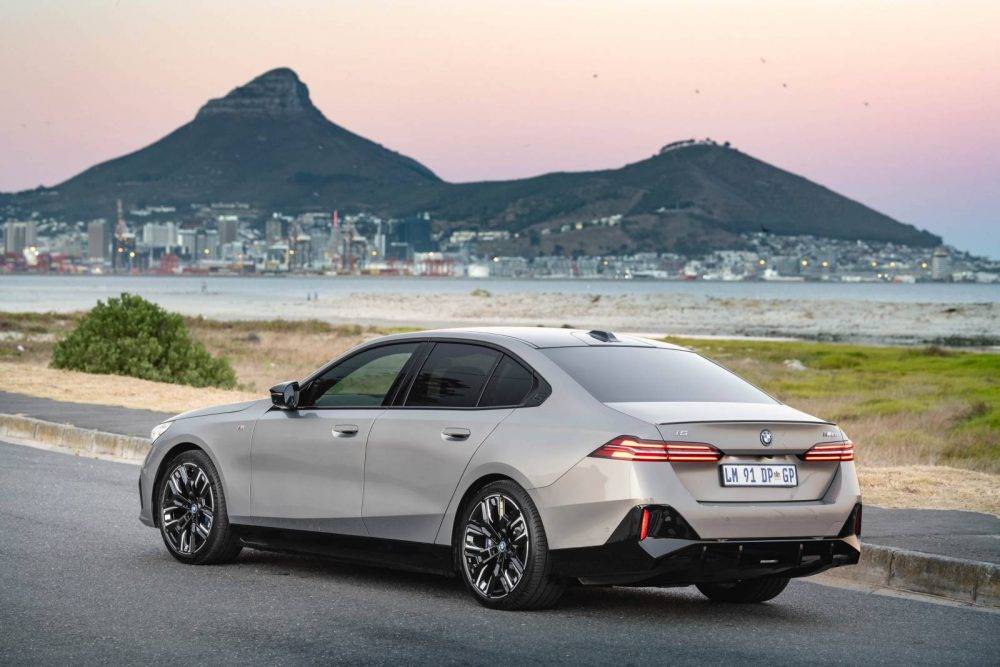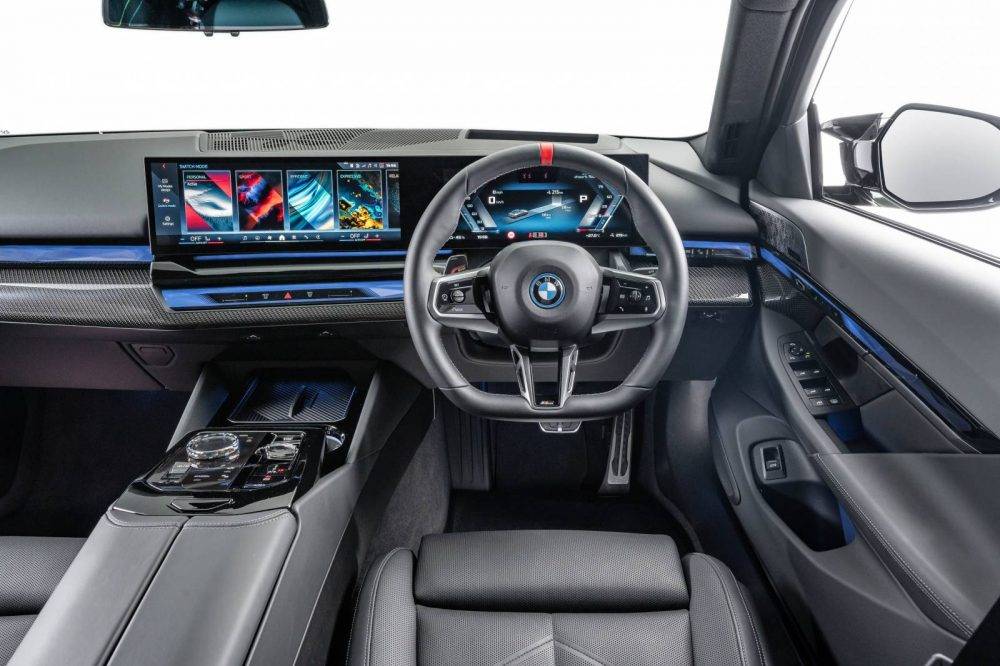Beaming: BMW launched its diesel 520d and the electric i5 M60 in Cape Town recently. The new range offers a sleek, modern exterior and improved cabin and is bigger and heavier than its predecessors.
BMW recently launched its mid-point-in-the-range sedan, the 5 Series, in Cape Town.
At the launch, the marque showcased two models for immediate roll-out and at different ends of the scale: the 520d, which offers a traditional diesel-power approach, and its electric i5 M60, with a performance bent.
Has it done enough, though?
Here’s the thing: the 5 Series has always been the middle point of access between the storied and immensely popular 3 Series and the crème-de-la-crème 7 Series. Less sporty than the 3, not quite as want-worthy as the 7. That’s an odd space to be in.
The good news is BMW has pulled out all the stops to make the new 5 Series very nearly worthy of poster space on a bedroom wall. Very nearly.
It’s a distinctly good-looking sedan, with a modern take on the twin headlights, a backtrack on the wildlife-ingesting and frankly huge nostrils — back to what you and I’d call tasteful — while the nighttime illuminated grille that is becoming a mainstay feature of new BMWs is carried over from the 7 Series.
As for the side profile, I’ll skip all the marketing fluff and tell you that it’s sleek, with an embossed 5 on the C-pillar to denote the car’s standing within the portfolio.
The side profile comes to a head at the rear, with bold lines and creases — note the indent between the boot and bumper.
If you’re interested in the specific exterior figures, bear with me. If you don’t feel the need to learn exactly what volume the exterior represents, feel free to skip to the next section.
Here goes… The 5 Series has grown in length by 97mm to 5 060mm, the first 5 to ever breach the 5m mark, which is quite apt.
Translation: This sedan has some size to it. It’s 32mm wider than its predecessors, at 1 900mm, and despite what the sleek side profile will have you believe, it’s higher too.

It stands at 1 515mm, which is an increase of 36mm, while the wheelbase has grown by 20mm to 2 995mm. For reference, that is 144mm more than the 3 and 256mm less than the 7.
And inside? Is it still as dull as dishwater?
No. Far from it. I like to think that all the ink I’ve smeared onto precious paper about BMW’s inherently unimaginative interior spaces had an effect on the design of the 7 Series, which launched last year.
More likely, though, is that someone in the interior-styling department woke up with the thought, “Hey, I wonder what Mercedes-Benz is doing with its cabins lately? Let’s try that.” The result is less space-filling button clutter and more reliance on digitisation.
It’s useful that most functions have been digitally embedded into the 12.3-inch instrument screen and 14.9-inch infotainment system, but the trade-off is navigating several layers to find certain operations, which adds complexity.
Linking your smartphone to either Android Auto or Apple CarPlay, for instance, requires a measure of patience and digital finesse. Then again, owning the car means a one-time connection. That’s it.
A further measure to reduce clutter includes the deletion of the traditional air vents. Instead, BMW opted for an air-slot-type system that is hidden from the driver and passengers, with a toggle to set height and a digital slider to set intensity.
The result, while not immediately noticeable in an I-wonder-where-the-air-vents-are way, is a clean-cut cabin worthy of Beemer’s immortal 5 Series.
If I had to pick nits about the more minimalist approach, it’s the hazard button — or rather the lack thereof — with a capacitive feedback button replacing the traditional physical depress button.
It’s finicky at best and here I’d say that BMW should have left well enough alone.
The specs — also an important bit… South Africa has had to do without the entirety of the model’s engine range. There are no petrol engines coming this way for the foreseeable future — until the mighty flagship M5 is released — and no 530d derivative. I’m sorry to be the bearer of bad news.
 The interior of the new BMW 5-Series
The interior of the new BMW 5-Series
However, what we do have is the sensible 520d and the stonkering i5 M60, with BMW saying the less bitey i5 40 is scheduled to arrive soon.
Rather poetically, the i5 M60 is equipped with BMW’s fifth-generation eDrive technology which, in real-world terms we actually care about, means it produces 442kW and 820Nm of torque.
I’ll give you a second to wrap your head around that.
That is thanks to two electric motors, the front one of which generates 192kW while the rear makes up the difference at 250kW.
Press the left-hand steering pedal labelled “Boost” and the vehicle accelerates from 0 to 100km/h in 3.8 seconds, only running out of steam at 230km/h.
All this potential is stored in the underbody battery, which has an 81.2 kilowatt-hour capacity.
On the more sensible side, the 520d is powered by BMW’s trusty 2.0-litre turbodiesel, mated to an 8-speed automatic transmission that produces 145kW and 400Nm of torque.
That looks conservative on paper, especially since it accelerates to 100km/h in a modest-in-comparison 7.3 seconds.
Sensible, yes but, as is the way of the 20d, it has serious charm even if its performance is unassuming.
It’s still a fantastic cruiser with the ability to easily collect speed for overtaking, despite its 1.8-tonne mass.
And, speaking of weight, it is relatively light in comparison to its 2.3-tonne electric sibling, and this is evident in the handling sphere.
Not to say that the i5 M60 handles like a log. Far from it, since BMW is a master at optimising its chassis to overcome the forces of nature and it’s evident in the i5.
That said, it just can’t match the sharpness of the much lighter 520d on anything resembling a bend. Where it shines, however, is on the acceleration front when that Boost paddle gets called into action.
It shoves you into your seat with an immediacy that’s not often experienced in the ICE realm.
And then it happens. The well-insulated, quiet cabin, which only reveals a faint hum from the wheels and a near-imperceptible woosh from wind colliding with the A-pillar, reverberates with a futuristic and increasingly urgent acoustic resonance.
The soundtrack was composed by Hollywood soundman Hans Zimmer to replace the artificial engine noise that generally comes out of the speakers of EVs.
The pitch and tone changes are directly related to speed and the urgency with which the accelerator pedal is squeezed. It’s a refreshing take on the future of mobility and an apt way for me to conclude this report.
The new 5 Series is proof that BMW isn’t merely keeping up with what the competition is doing. Instead, it is forging its own path into electric mobility, while staying true to what we love about these sedans.
There is little in the way of foreign concepts and more of a focus on improving on what’s already working.
The safety aspect is another example. BMW has introduced its active lane change system with this generation of vehicles. This requires the driver to indicate, check the blind spots and, when safe, the car will automatically change lanes without further input from the driver.
Whether you opt for diesel or electric, the 5 Series is a sumptuously appointed sedan that’s taking its rightful place within the BMW model hierarchy.
What’s more, you can choose the sensible route with the frugal 520d (R1 247 893), which will win back a large portion of the price with savings on fuel consumption, boosted by 48V mild-hybrid assistance.
Or you can opt for the futurism-in-a-familiar-package i5 M60 at R2 190 000, inclusive of a wallbox and installation.
If it’s a more middle-ground offering you’re after, the i5 M40, scheduled to arrive later this year, will probably make a competitive case for itself within the EV space at R1 842 500, including a wallbox and installation.